
A knot is an intentional complication in cordage which may be practical or decorative, or both. Practical knots are classified by function, including hitches, bends, loop knots, and splices: a hitch fastens a rope to another object; a bend fastens two ends of a rope to each another; a loop knot is any knot creating a loop; and splice denotes any multi-strand knot, including bends and loops. A knot may also refer, in the strictest sense, to a stopper or knob at the end of a rope to keep that end from slipping through a grommet or eye. Knots have excited interest since ancient times for their practical uses, as well as their topological intricacy, studied in the area of mathematics known as knot theory.
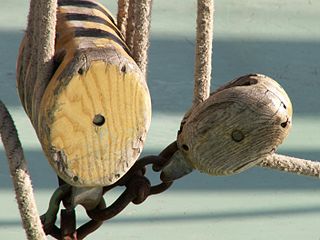
A pulley is a wheel on an axle or shaft enabling a taut cable or belt passing over the wheel to move and change direction, or transfer power between itself and a shaft. A sheave or pulley wheel is a pulley using an axle supported by a frame or shell (block) to guide a cable or exert force.
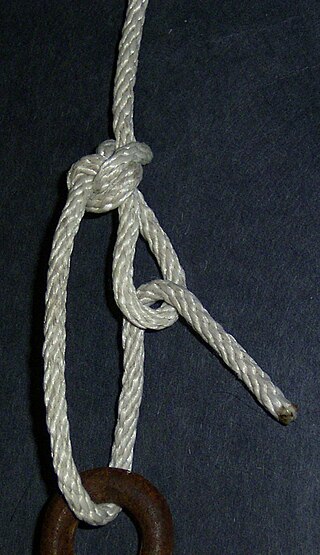
The trucker's hitch is a compound knot commonly used for securing loads on trucks or trailers. The general arrangement, using loops and turns in the rope itself to form a crude block and tackle, has long been used to tension lines and is known by multiple names. Knot author Geoffrey Budworth claims the knot can be traced back to the days when carters and hawkers used horse-drawn conveyances to move their wares from place to place.

The taut-line hitch is an adjustable loop knot for use on lines under tension. It is useful when the length of a line will need to be periodically adjusted in order to maintain tension. It is made by tying a rolling hitch around the standing part after passing around an anchor object. Tension is maintained by sliding the hitch to adjust the size of the loop, thus changing the effective length of the standing part without retying the knot.

The klemheist knot or French Machard knot is a type of friction hitch that grips the rope when weight is applied, and is free to move when the weight is released. It is used similarly to a Prusik knot or the Bachmann knot to ascend or descend a climbing rope. One advantage is that webbing can be used as an alternative to cord. The Klemheist is easier to slide up than a Prusik. The klemheist is also a way to attach a snubber to the anchor rope of small boats, with the advantage that it is easy to undo.

A block and tackle or only tackle is a system of two or more pulleys with a rope or cable threaded between them, usually used to lift heavy loads.

Rope rescue is a subset of technical rescue that involves the use of rope, be it steel or cable rope, or more commonly used nylon, polyester, or other type of rope. Kernmantle rope as it is called, is available in various types: dynamic or static which is most commonly used in rescue and industrial rope work. Anchoring includes using specialty anchors, as well as things as simple as a length of chain, cable, rope, or webbing wrapped around a pillar, tree, boulder, or such. They provide the security and a point from which a person or subject can be belayed. Belaying is the act of protecting the climber, rescue professional, or subject in the event of a fall. Various other devices used, including friction rappel (lowering) devices, which acts as a braking device on the rope. They are used for lowering a load, a subject or oneself (rappelling). Pulleys can serve as a mechanical advantage, along with rope grabs, and other tools, to raise, or haul, a load up a vertical section, or across a gully or canyon. Pulleys systems are used in conjunction with the rope, rope grabbing devices, i.e.: Prusiks, or mechanical grabs, to capture the progress made during the lift. Since pulley systems are generally short in length, they are used in conjunction with a progress (raise) capturing technique, and a long rope; and a backup safety or belay. This specialized equipment is used to reach the subject(s) and safely recover them.

Crevasse rescue is the process of retrieving a climber from a crevasse in a glacier. As a result of the frequency with which climbers break through the snow over a crevasse and fall in, crevasse rescue technique is a standard part of climbing education.
Self-locking devices are devices intended to arrest the fall of solo climbers who climb without partners. This device is used for rope solo climbing, for "ground-up climbing", and for "top rope solo climbing". To date, several types of self-locking devices have evolved.

The Munter hitch, also known as the Italian hitch, mezzo barcaiolo or the crossing hitch, is a simple adjustable knot, commonly used by climbers, cavers, and rescuers to control friction in a life-lining or belay system. To climbers, this hitch is also known as HMS, the abbreviation for the German term Halbmastwurfsicherung, meaning half clove hitch belay. This technique can be used with a special "pear-shaped" HMS locking carabiner, or any locking carabiner wide enough to take two turns of the rope.

The Bachmann hitch is a friction hitch, named after the Austrian alpinist Franz Bachmann. It is useful when the friction hitch needs to be reset quickly or often or made to be self-tending as in crevasse and self-rescue.

An ascender is a device used for directly ascending a rope, or for facilitating protection with a fixed rope when climbing on very steep mountain terrain.

The rolling hitch is a knot used to attach a rope to a rod, pole, or another rope. A simple friction hitch, it is used for lengthwise pull along an object rather than at right angles. The rolling hitch is designed to resist lengthwise movement for only a single direction of pull.
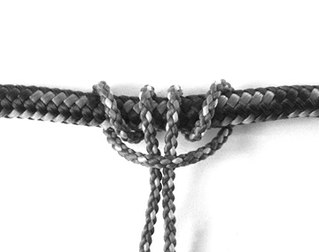
A Prusik is a friction hitch or knot used to attach a loop of cord around a rope, applied in climbing, canyoneering, mountaineering, caving, rope rescue, ziplining, and by arborists. The term Prusik is a name for both the loops of cord used to tie the hitch and the hitch itself, and the verb is "to prusik". More casually, the term is used for any friction hitch or device that can grab a rope. Due to the pronunciation, the word is often misspelled Prussik, Prussick, or Prussic.

An autoblock is a rope device used in climbing and caving for both rappelling (downward) and ascending (upward).
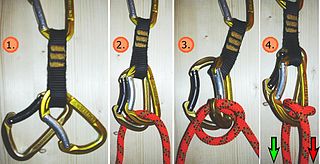
The Garda Hitch, also known as the Alpine Clutch, is a type of climbing knot that can only be moved in one direction. It is often used in climbing and mountaineering, such as in pulley systems to haul loads up a cliff. However, the Garda Hitch has some drawbacks, including being difficult to release under load, difficult to inspect, and adding significant friction to a pulley system. It can be challenging to determine which direction the rope will move freely and which direction it will lock just by looking at it. To tie a Garda Hitch, you need two similar carabiners, and it works best with two identical oval carabiners. While "D" carabiners can also be used, there is a risk of them unclipping.
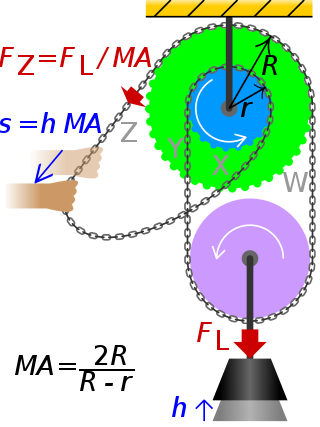
A differential pulley —also called "Weston differential pulley", sometimes "differential hoist", "chain hoist", or colloquially "chain fall"— is used to manually lift very heavy objects like car engines. It is operated by pulling upon the slack section of a continuous chain that wraps around two pulleys on a common shaft. The relative sizing of the two connected pulleys determines the maximum weight that can be lifted by hand. If the pulley radii are close enough, then the load will remain in place until the chain is pulled.
















